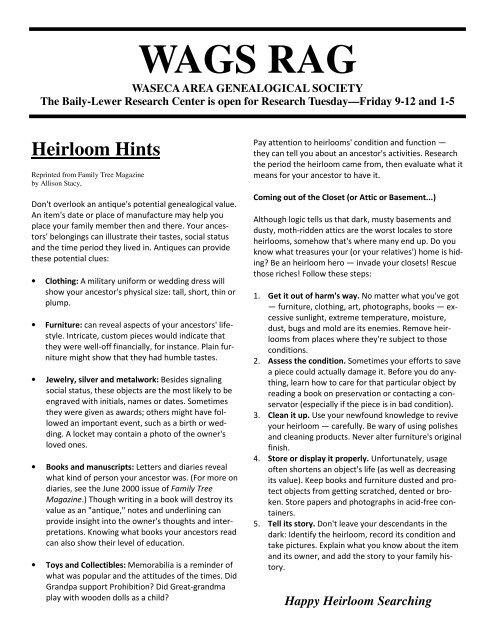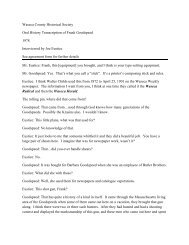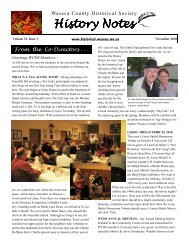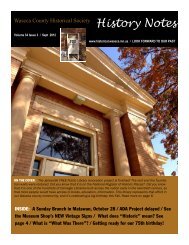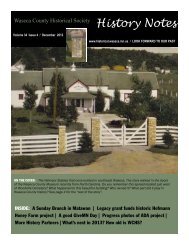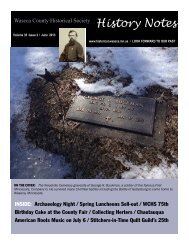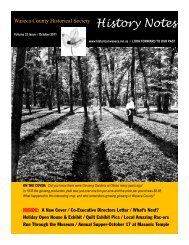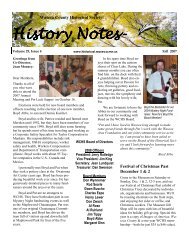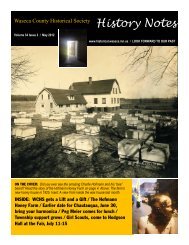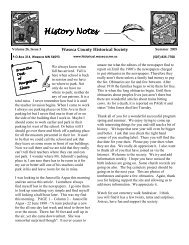Fall - History Notes History Notes - Waseca County Historical Society
Fall - History Notes History Notes - Waseca County Historical Society
Fall - History Notes History Notes - Waseca County Historical Society
You also want an ePaper? Increase the reach of your titles
YUMPU automatically turns print PDFs into web optimized ePapers that Google loves.
WAGS RAG<br />
WASECA AREA GENEALOGICAL SOCIETY<br />
The Baily-Lewer Research Center is open for Research Tuesday—Friday 9-12 and 1-5<br />
Heirloom Hints<br />
Reprinted from Family Tree Magazine<br />
by Allison Stacy,<br />
Don't overlook an antique's potential genealogical value.<br />
An item's date or place of manufacture may help you<br />
place your family member then and there. Your ancestors'<br />
belongings can illustrate their tastes, social status<br />
and the time period they lived in. Antiques can provide<br />
these potential clues:<br />
• Clothing: A military uniform or wedding dress will<br />
show your ancestor's physical size: tall, short, thin or<br />
plump.<br />
• Furniture: can reveal aspects of your ancestors' lifestyle.<br />
Intricate, custom pieces would indicate that<br />
they were well-off financially, for instance. Plain furniture<br />
might show that they had humble tastes.<br />
• Jewelry, silver and metalwork: Besides signaling<br />
social status, these objects are the most likely to be<br />
engraved with initials, names or dates. Sometimes<br />
they were given as awards; others might have followed<br />
an important event, such as a birth or wedding.<br />
A locket may contain a photo of the owner's<br />
loved ones.<br />
• Books and manuscripts: Letters and diaries reveal<br />
what kind of person your ancestor was. (For more on<br />
diaries, see the June 2000 issue of Family Tree<br />
Magazine.) Though writing in a book will destroy its<br />
value as an "antique," notes and underlining can<br />
provide insight into the owner's thoughts and interpretations.<br />
Knowing what books your ancestors read<br />
can also show their level of education.<br />
• Toys and Collectibles: Memorabilia is a reminder of<br />
what was popular and the attitudes of the times. Did<br />
Grandpa support Prohibition? Did Great-grandma<br />
play with wooden dolls as a child?<br />
Pay attention to heirlooms' condition and function —<br />
they can tell you about an ancestor's activities. Research<br />
the period the heirloom came from, then evaluate what it<br />
means for your ancestor to have it.<br />
Coming out of the Closet (or Attic or Basement...)<br />
Although logic tells us that dark, musty basements and<br />
dusty, moth-ridden attics are the worst locales to store<br />
heirlooms, somehow that's where many end up. Do you<br />
know what treasures your (or your relatives') home is hiding?<br />
Be an heirloom hero — invade your closets! Rescue<br />
those riches! Follow these steps:<br />
1. Get it out of harm's way. No matter what you've got<br />
— furniture, clothing, art, photographs, books — excessive<br />
sunlight, extreme temperature, moisture,<br />
dust, bugs and mold are its enemies. Remove heirlooms<br />
from places where they're subject to those<br />
conditions.<br />
2. Assess the condition. Sometimes your efforts to save<br />
a piece could actually damage it. Before you do anything,<br />
learn how to care for that particular object by<br />
reading a book on preservation or contacting a conservator<br />
(especially if the piece is in bad condition).<br />
3. Clean it up. Use your newfound knowledge to revive<br />
your heirloom — carefully. Be wary of using polishes<br />
and cleaning products. Never alter furniture's original<br />
finish.<br />
4. Store or display it properly. Unfortunately, usage<br />
often shortens an object's life (as well as decreasing<br />
its value). Keep books and furniture dusted and protect<br />
objects from getting scratched, dented or broken.<br />
Store papers and photographs in acid-free containers.<br />
5. Tell its story. Don't leave your descendants in the<br />
dark: Identify the heirloom, record its condition and<br />
take pictures. Explain what you know about the item<br />
and its owner, and add the story to your family history.<br />
Happy Heirloom Searching


